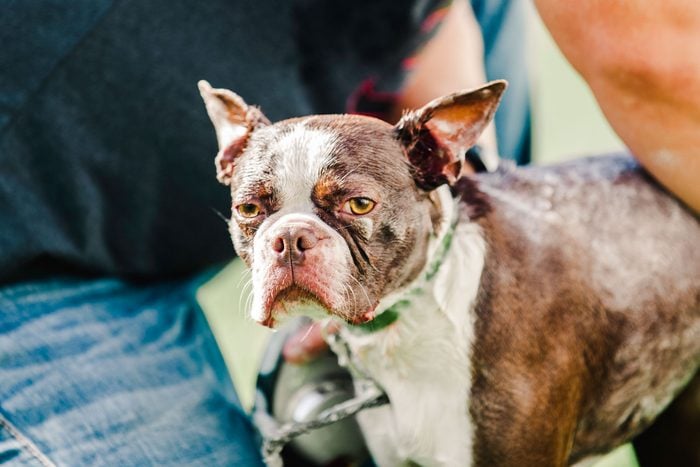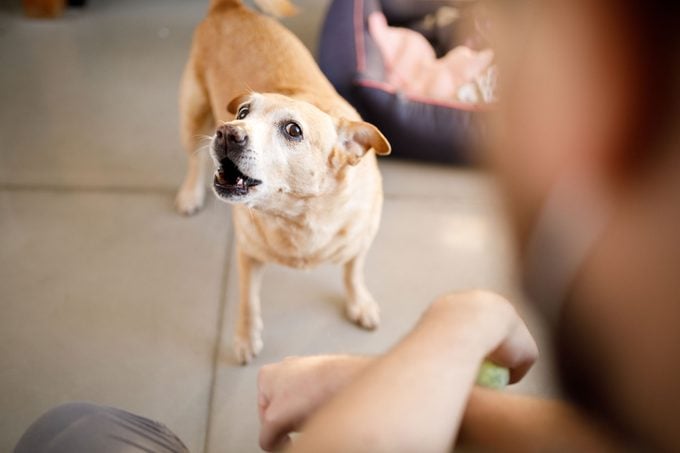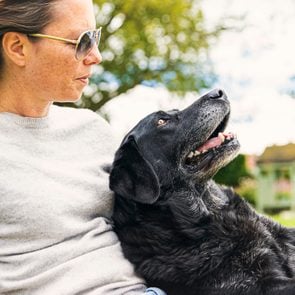Is My Dog Mad at Me? Telltale Signs and How to Respond
Updated: Apr. 23, 2024

There's no doubt dogs experience deep emotions, but do they get angry with us? Here, top canine experts explain why your dog may be mad at you—and what you can do about it.
If you’ve ever playfully teased a dog, you know it’s all fun and games until, well, it’s no longer fun. After you’ve stolen a dog’s bone or pretended to throw a ball one too many times, the dog may bark, stiffen, growl or even walk away. Most pet owners have been there, sheepishly wondering Is my dog mad at me?
Can dogs even get angry? What about frustrated or annoyed? It sure seems that way sometimes. Even though we’re different species, it’s tempting to interpret dog behavior through a human lens. After all, when it comes to emotions, we have a lot in common with our four-legged friends.
In over 13 years as a certified professional dog trainer, I’ve come to appreciate that dogs share many of the same basic feelings we do. My Chihuahua gets scared during fireworks shows, happy when he plays with his snuffle mat and, yes, angry when he is removed from a lap. I appreciate those feelings, encourage the positive ones and help alleviate the negative ones. Once you can recognize emotions like anger in your dog, you can better empathize and respond.
With that in mind, I asked three canine behavior experts to help me explore doggy anger. Ahead, learn why it happens, what it looks like and how to respond.
Get Reader’s Digest’s Read Up newsletter for more pet insights, humor, travel, tech and fun facts all week long.
About the experts
|
Do dogs get mad?
Yes, dogs get mad. But “Is my dog mad at me?” isn’t such a simple question. See, when we talk about anger, we do so from a very human perspective, considering secondary emotions that often tangle with anger. We might say a child is mad when he’s really a mix of angry and jealous or embarrassed.
It’s human nature to treat animal emotions similarly. So you might wonder if your pet is resentful of your plate of chicken, jealous that you’re paying more attention to the cat or exasperated with your absorption in your cell phone. Truth is, your pooch probably feels none of the above, although the jury is still out on jealousy. Canine anger is a much simpler emotion.
What does it mean when a dog is mad?
If you’re asking “Is my dog mad at me?” and speaking specifically about rage, the science is clearer. To understand it, you need to know the difference between emotions that are considered basic, or primary, and those considered sophisticated, or secondary.
Jaak Panksepp, a neuroscientist who pioneered the science of how the brain processes emotions, developed the concept of the seven primary emotions, which he said all mammalian brains shared. Those systems, as he called them, are seeking (exploring for resources), care (nurturing), play (social joy), lust, fear (anxiety), panic (sadness) and rage (anger). They’re instinctive emotions and very different from secondary emotions, like jealousy, that involve a component of learning and experience.
It’s not surprising that dogs share these primary emotions with us. According to veterinary psychiatrist Sagi Denenberg, DVM, a diplomate of the American College of Veterinary Behavior, dogs have brain structures and neurochemistry similar to humans. Plus, they show similar behaviors in similar situations.
But that doesn’t mean their actions reflect sophisticated emotions—emotions pet owners are quick to attribute to their furry best friends. “We have to be careful of anthropomorphism,” Dr. Denenberg says. “Animals are not human, nor should they be treated as such. Many behaviors or emotions are based on interpretation and colored by differing thought processes and cultural, religious and societal factors, which are human factors.”
Why is your dog mad?
If dogs can experience anger and rage, they can definitely get mad at humans, just as we can get angry with them. But it’s important to realize that although we share emotions with dogs, we don’t necessarily experience them the same way. Your dog’s motivation for anger may not be the same as yours. For example, dogs don’t do things to be vindictive or out of spite, but they do get frustrated.
And the types of situations that might trigger you can trigger your dog. Certified dog behavior consultant Michael Shikashio points to a common problem with resource-guarding dogs that become upset when their food or chew bones are taken away. “If you’re really hungry and you’re sitting down at your favorite restaurant and somebody comes over and snatches your plate away or sticks their hand in your food,” he says, “you might get startled at first, so there’s that fear system, but then it can quickly shift over to rage or anger.”
Signs your dog is mad at you
There’s no one-size-fits-all response to anger—for humans or animals. Think about it: Some people lash out physically when angry; others scream and shout, while others give the silent treatment. “I like to say there’s human joy, dog joy, cat joy, chimpanzee joy, etc., and there may be differences within species, just as there are among humans,” says Marc Bekoff, PhD, professor emeritus of ecology and evolutionary biology at the University of Colorado in Boulder. “So it’s essential to appreciate that individuals may vary with how they experience and express their emotions, and that is what makes the study of the emotional lives of animals so fascinating.”
He’s seen firsthand how dogs react to anger in disparate ways. “Among the many dogs with whom I’ve shared my home, there were differences—some simply avoided me or another human, whereas others clearly told me they were upset by barking at me or snarling or growling,” he says.
Although dogs’ reactions can vary, the signs below will help you identify when they’re angry.
Aggression

When dogs are truly angry, they might threaten you or even attack you. Such a dramatic response will occur if you push dogs past what they can handle—maybe you steal a hungry dog’s food or force physical contact (like grooming or pats) on a dog experiencing pain. Even actions you think are benign, such as patting a dog on the top of the head or staring, could lead to anger because they’re considered rude in dog language. Different dogs have different triggers for their anger.
But what does that aggressive anger look like? It can range from lunging at the source of anger to warning you off with a low growl. Although some dogs growl when they play, most dogs also use growling to say, “You’re making me uncomfortable. Please stop!” The more you understand dog vocalizations and canine body language, the better you’ll be able to recognize your dog’s frustration and rage.
Shikashio advises looking for forward-facing ears, hard staring (a gaze fixed on the target) and an agonistic pucker (corners of the lips pulled forward into a C shape and teeth bared).
But there are other signs of anger as well. “Their weight shifts forward, [their] front and rear legs usually stiffen and go straight, their spine is in straight alignment and their tail is often high and flagging,” he says. “Rapid-fire, kind of staccato barking is another sign the dog might be experiencing rage or anger.”
The signs aren’t always that cut and dried, though. “It is not always that simple to differentiate,” Dr. Denenberg says. “Dogs may experience multiple emotions simultaneously.” Just as you might experience excitement and fear at the same time, for instance, an anxious dog might be angry about being forced into a scary situation.
Avoidance

Angry dogs aren’t always aggressive. Instead of barking or growling when mad, some dogs might simply avoid you. You might see pooches turn their heads, sniff the ground or otherwise disengage. Or it might be more obvious: Your dog walks away or right out of the room.
Don’t just assume avoidance indicates anger, though. These behaviors could also be a response to stress—for example, if you yell at or punish your dog. Or your dog may simply want some quiet time alone.
To determine your dog’s motivation for avoiding you, consider the situation that instigated it. Did you do something to annoy your pet? Or have you done something frightening? Look at the accompanying body language: Are there signs of stress, like pulled-back ears, yawning or a tucked tail? Or is your dog tuning you out? By examining the whole package, you should be able to tell if your dog is angry or feeling another emotion.
How to respond to your dog’s anger
When your dog expresses anger, it’s important to empathize. After all, anger is a natural emotion for both us and our dogs. And just as reacting with anger to another person’s rage isn’t the most effective course of action, you shouldn’t respond to your dog’s anger with further conflict. Don’t yell at your pet or use physical confrontation. This will only escalate the situation and put your dog in a defensive position, which can lead to aggressive behavior such as snapping or biting. You could also make your pet fearful of you, thereby eroding your bond.
Think like a dog
Shikashio suggests self-reflection as a starting point. “Ask, ‘Why would my dog need to feel anger or rage toward me or somebody else?’ And it’s typically because of what we’re doing,” he says. “It’s hard not to take offense to that, especially if we’re the ones feeding the dog. You can be like, ‘How dare you bite the hand that feeds you?’ But it’s just a very normal, basic emotion that all of us can experience.”
Not only do you need to know how to read dog communication, but you must also understand your dog specifically. “It’s essential to understand that there are large individual differences among dogs, and we must learn and appreciate these differences, even among littermates and older siblings,” Bekoff says. “To be able to figure out what a dog is feeling, we need to be fluent in dog—become dog literate—to be able to read them accurately and do what they need to reduce their anger.”
De-escalate the situation

In the short term, Dr. Denenberg recommends putting safety first. If your dog is expressing anger through aggressive behaviors (such as growling or barking) or is threatening you, stop what you’re doing and give your pup some space. That might mean moving away from your dog and/or trying to stop the situation from escalating. Forcing your attention or a certain set of circumstances on your dog puts you at risk.
If your dog isn’t aggressive but has chosen to avoid you, simply wait. Dogs tend to live in the moment, so you likely won’t have to wait long for the anger to subside. Give your dog at least a few minutes to calm down, and the next thing you know, your loving pet will be back at your side. From a human perspective, you might call this forgiving and forgetting.
Feel free to cuddle dogs or offer them treats when their anger has passed, especially if it makes you feel better. It serves as an apology of sorts, but your dog will just be happy the incident is in the past.
Teach alternative responses
Once safety is established and your dog has calmed down, it’s time to analyze the situation. Identify what triggered the anger so you can try to avoid similar situations in the future.
Just know that you can’t avoid every trigger. For example, if your dog gets mad at the groomer’s, you can’t avoid grooming forever. Therefore, it’s a good idea to teach your dog how to cope with those triggers and respond with more positive emotions.
You might try counterconditioning, pairing the trigger with something the dog loves, like chicken or freeze-dried liver. This will slowly change your pup’s emotional response to the situation from something negative, like anger, to something positive, like anticipation of a treat.
You can also try response substitution. With this technique, you’ll teach your dog an alternative response to the trigger that you can then reward with a treat or other item the dog loves, like a game of fetch. For example, if your dog gets angry when you approach the food bowl, teach your pet to lie down on a dog bed at mealtime so you can pick up and fill the bowl undisturbed before calling your dog over to eat. With consistency and repetition, your pooch should learn to offer that response.
“It is about setting dogs up to succeed,” Dr. Denenberg says. “Owners can also work on desensitizing the dog to a particular situation, which is done under ideal conditions before the dog is triggered. Lastly, environmental and routine management can help by avoiding the situation.”
Why trust us
At Reader’s Digest, we’re committed to producing high-quality content by writers with expertise and experience in their field in consultation with relevant, qualified experts. For this piece, Stephanie Gibeault, MSc, CPDT-KSA, tapped her experience as a certified professional dog trainer and journalist, and then Wailani Sung, DVM, a vet who owns Bay Area Vet Behavior, gave it a rigorous review to ensure that all information is accurate and offers the best possible advice to readers. We verify all facts and data, back them with credible sourcing and revisit them over time to ensure they remain accurate and up to date. Read more about our team, our contributors and our editorial policies.
Sources:
- Marc Bekoff, PhD, professor emeritus of ecology and evolutionary biology at the University of Colorado in Boulder and author of several books, including Dogs Demystified: An A-to-Z Guide to All Things Canine and The Emotional Lives of Animals; email interview, March 25, 2024
- Sagi Denenberg, DVM, veterinary behaviorist at North Toronto Veterinary Behaviour Specialty Clinic; email interview, March 29, 2024
- Michael Shikashio, CDBC, certified dog behavior consultant and founder of the Aggression in Dogs Master Course; video interview, March 29, 2024
- Frontiers in Neuroscience: “Selected Principles of Pankseppian Affective Neuroscience”
- Psychological Science: “Dogs Mentally Represent Jealousy-Inducing Social Interactions”




